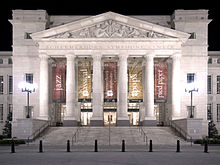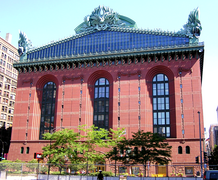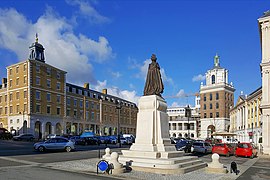New Classical architecture

New Classical architecture, New Classicism or the New Classical movement is a contemporary movement in architecture that continues the practice of Classical architecture. It is sometimes considered the modern continuation of Neoclassical architecture,[1][2][3] even though other styles might be cited as well, such as Gothic, Baroque, Renaissance or even non-Western styles.[4]
The design and construction of buildings in ever-evolving classical styles is continuous throughout the 20th and 21st centuries, even as modernist and other non-classical theories broke with the classical language of architecture. The new classical movement is also connected to a surge in new traditional architecture, that is crafted according to local building traditions and materials.[5]
Development[]

In Britain, architect Raymond Erith continued to design classical houses into the late 1960s and early 1970s. Quinlan Terry, a New Classical Architect who continues to practice, was an employee, later a partner and now the successor of the late Raymond Erith. French architect François Spoerry also continued to create classical designs from the 1960s onwards, later culminating in the European Urban Renaissance. In the late 1970s several young architects in Europe began challenging modernist proposals in architecture and planning. To broadcast them, Leon Krier and founded the Archives d'Architecture Moderne in Brussels and began publishing texts and counterprojects to modernist proposals in architecture and planning.[6] It received a boost from the sponsorship of Charles, Prince of Wales, especially with The Prince's Foundation for Building Community.[7]

In these years, postmodern architecture developed a critique of modernist architectural aesthetics.[8] Among them were certain influential postmodernist architects such as Charles Moore, Robert Venturi,[9] and Michael Graves, who used classical elements as ironic motifs in order to criticize modernism's sterility. A broad spectrum of more than two dozen architects, theorists, and historians presented other alternatives to modernism.[10] Among them were several serious New Classical architects who saw classicism as a legitimate mode of architectural expression, several of whom would later become Driehaus Prize Laureates, including some such as Thomas Beeby and Robert A.M. Stern, who practice both in post modern as well as classical modes. Some postmodernist firms, such as Stern and Albert, Righter, & Tittman, fully moved from postmodern design to new interpretations of traditional architecture.[8] Thomas Gordon Smith, the 1979 Rome Prize laureate from the American Academy in Rome, was a devotee of Charles Moore. In 1988, Smith published "Classical Architecture - Rule and Invention", and, in 1989, was appointed to chair of the University of Notre Dame Department of Architecture, now the School of Architecture, that specialized in teaching classical and traditional building practices.[11] Today, other programs exist which teach in part New Classical Architecture at the University of Miami, Judson University, Andrews University and beginning in 2013,[12] the Center for Advanced Research in Traditional Architecture at the University of Colorado Denver.
Alongside these academic and scholarly developments, a populist and professional manifestation of new classicism has existed and continues to develop. The 1963 demolition of McKim, Mead & White's Pennsylvania Railroad Station in New York City provoked the formation of Classical America and its regional chapters, led by Henry Hope Reed, Jr..[13] Classical America advocated the appreciation of classically inspired buildings and for the practice of contemporary classical and traditional design by teaching architects to draw the classical orders, hosting walking tours, educational events, conferences and publishing The Classical America Series in Art and Architecture.[14]
In 2002, the then-named Institute of Classical Architecture merged with Classical America to form the Institute of Classical Architecture & Classical America (now the Institute of Classical Architecture and Art). The ICAA currently supports and is supported by regional chapters across the United States, almost all of which host awards programs [15] which recognize significant accomplishments in new classical and traditional design and construction. The ICAA publishes ,[16] a peer-reviewed journal exclusively dedicated to the theory and practice of contemporary classicism in architecture, urbanism, and the allied arts. The ICAA offers educational programs to architecture and design professionals, many of which follow the methodologies of the École des Beaux-Arts. The ICAA also teaches courses to educate the general public,[17] and has created programs such as the Beaux Arts Atelier, the Advanced Program in Residential Design for the American Institute of Building Designers, and many other unique programs.
The international character of the New Classical movement was propelled by the creation in 2001 of the International Network for Traditional Building, Architecture & Urbanism (INTBAU),[18] an international organization dedicated on supporting traditional building and the maintenance of local character.[19] INTBAU spans more than 40 countries with its local chapters.[20] This network was created under the patronage of Charles, Prince of Wales himself an important figure in the New Classical movement.[21]
In 2003, Chicago philanthropist Richard H. Driehaus established[22] a prize in architecture to be given to an architect "whose work embodies the principles of classical and traditional architecture and urbanism in society, and creates a positive, long lasting impact." Awarded by the University of Notre Dame School of Architecture, the Driehaus Architecture Prize is seen as the alternative to the modernist Pritzker Prize. The Driehaus Prize is given in conjunction with the Reed Award, for an individual working outside the practice of architecture who has supported the cultivation of the traditional city, its architecture and art through writing, planning or promotion.[23] Other high-profiled classical architecture awards are the US-American Palladio Award,[24] the Iberian Rafael Manzano Prize,[25] the ,[26] and the [27] of the Institute of Classical Architecture and Art (ICAA) for architecture graduates.
Philosophy[]

New Classical architecture is complementary architecture focused on a modus operandi that emphasizes the awareness of sustainability, the aim is to create long-lasting, well-crafted buildings of great quality, adapted to the context and with an efficient use of natural resources.[28] It achieves this by balancing the economic domain with a long-term architectural landscaping that is more responsible for sustainability in the ecological domain.[29]
Educational institutions[]
While modernist teaching remains dominant at universities and architecture faculties around the world, some institutions focus solely, mainly or partly on teaching the principles of traditional and classical architecture and urban planning. Some of these are:[30]
- In Brazil
- In India
- Tirumala S.V. Institute of Traditional Sculpture and Architecture (SVITSA), in Tirupati, Andhra Pradesh.[32]
- In Italy
- Polytechnic University of Bari, in Bari.[33]
- In New Zealand
- UNITEC Institute of Technology, in Auckland.[33]
- In the United Kingdom
- National Design Academy, in Nottingham (heritage interior design).[34]
- The Prince's Foundation for Building Community, in London.
- The Prince's School of Traditional Arts, in London.
- Unit 6 of the Kingston School of Art's Master of Architecture program,[35] the only postgraduate unit in the United Kingdom to teach classical design. Previously, this was taught in the undergraduate program.
- University of Portsmouth, in Portsmouth, School of Architecture.[36]
- at Welsh School of Architecture, Cardiff University, in Cardiff, Wales.
- In the United States
- Andrews University, in Berrien Springs, Michigan.[37]
- American College of the Building Arts.[38] and School of the Arts at College of Charleston, in Charleston, South Carolina.
- The Center for Advanced Research in Traditional Architecture at the University of Colorado, in Denver, Colorado.
- University of Miami, in Coral Gables, Florida.[39]
- Yale School of Architecture, in New Haven, Connecticut.[40]
- Grand Central Academy of Art formerly hosted at the Institute of Classical Architecture & Art (ICAA), in New York City, New York.
- Institute of Classical Architecture & Art (ICAA), in New York City, New York.
- University of Notre Dame School of Architecture, in Notre Dame, Indiana.
- Utah Valley University, in Orem, Utah.[41]
- Beaux-Arts Academy, in Salt Lake City, Utah.[42]
- Academy of Classical Design, in Southern Pines, North Carolina.
Examples[]

The Seat of the Universal House of Justice on Mount Carmel in Haifa, Israel, 1983, by Hossein Amanat

Richmond Riverside, London, England, 1984–87, by Quinlan Terry.

Harold Washington Library in Chicago, Illinois, USA, 1991, by HBRA Architects

Brentwood Cathedral, Brentwood, England, 1991, by Quinlan Terry

Maitland Robinson Library, Cambridge, England, 1992, by Quinlan Terry

Poundbury, England, 1993, by Léon Krier

Garden Pavilion at Edgewater, 1997, by Michael Dwyer
Nancy Lee and Perry R. Bass Performance Hall, Fort Worth, Texas, USA, 1998, by David M. Schwarz

Main Plaza, Frankfurt, Germany, 2001, by Hans Kollhoff

Queen's Gallery, London, England, 2002, by John Simpson
Ritz-Carlton Hotel, Moscow, Russia, 2007, by Meerson Architects

Shrine of Our Lady of Guadalupe, La Crosse, Wisconsin, USA, 2004–2008, by Duncan G. Stroik

Royal Air Force Bomber Command Memorial, London, England, 2012, by Liam O'Connor
See also[]
- New Urbanism
- Complementary architecture
- Revivalism (architecture)
- Classical Realism
- Driehaus Architecture Prize
- Traditional architecture
- Outline of classical architecture
References[]
- ^ Machalinski, Anne. "Classical Contemporary Meets the Future". www.mansionglobal.com. Retrieved 2021-01-12.
- ^ Curl, James Stevens, 1937- (2006). A dictionary of architecture and landscape architecture. Curl, James Stevens, 1937- (2nd ed.). Oxford [England]: Oxford University Press. ISBN 978-0-19-280630-7. OCLC 64585874.CS1 maint: multiple names: authors list (link)
- ^ Curl, James Stevens; Wilson, Susan (2015). "New Classicism". The Oxford Dictionary of Architecture. Oxford University Press. pp. 520–522. ISBN 978-0-19-967498-5.
- ^ "6 Classical Buildings That Are Younger Than You Think". ArchDaily. 2015-04-19. Retrieved 2021-02-18.
- ^ Quigley, Kathleen. "Inside Architecture's New Classicism Boom". Architectural Digest. Retrieved 2019-02-16.
- ^ Leon Krier and Maurice Culot, "Counterprojets: Prefaces," (Brussels: Archives d'Architecture Moderne, 1980).
- ^ Charles, Prince of Wales, "A Vision of Britain: A Personal View of Architecture," (New York: Doubleday, 1989).
- ^ a b McAlester, Virginia Savage (2013). A Field Guide to American Houses. Alfred A. Knopf. pp. 664–665, 668–669. ISBN 978-1-4000-4359-0.
- ^ Robert Venturi, "Complexity and Contradiction in Architecture," (New York: Museum of Modern Art, 1966).
- ^ Andreas Papadakis and Harriet Watson, eds., "New Classicism: Omnibus Volume," (London: Academy Editions, 1990).
- ^ "Many Canons, Many Conversions -". blogs.nd.edu. Archived from the original on 29 October 2013. Retrieved 3 May 2018.
- ^ "College of Architecture and Planning at CU Denver" (PDF). Archived (PDF) from the original on 2013-10-29. Retrieved 2013-10-26.
- ^ "How Henry Hope Reed Saved Architecture". The New York Sun. Archived from the original on 20 October 2017. Retrieved 3 May 2018.
- ^ "Books - Institute of Classical Architecture & Art". www.classicist.org. Archived from the original on 20 June 2017. Retrieved 3 May 2018.
- ^ "Articles - Institute of Classical Architecture & Art". blog.classicist.org. Archived from the original on 14 November 2010. Retrieved 3 May 2018.
- ^ "Books - Institute of Classical Architecture & Art". www.classicist.org. Archived from the original on 10 October 2017. Retrieved 3 May 2018.
- ^ "Calendar". www.classicist.org. Archived from the original on 13 October 2017. Retrieved 3 May 2018.
- ^ Guardian Staff (2002-02-11). "Hooked on classics: in praise of traditional architecture". The Guardian. ISSN 0261-3077. Retrieved 2020-02-27.
- ^ "About Us | INTBAU". Retrieved 2020-02-27.
- ^ "Chapters | INTBAU". Retrieved 2020-02-27.
- ^ "United Kingdom: New crown coin celebrates the 70th birthday of HRH Charles, Prince of Wales | Coin Update". news.coinupdate.com. Retrieved 2020-02-27.
- ^ "The Driehaus Prize". wttw.com. 7 March 2013. Archived from the original on 23 October 2017. Retrieved 3 May 2018.
- ^ "Driehaus Prize Nomination Process". University of Notre Dame School of Architecture. Archived from the original on 29 March 2013. Retrieved 11 February 2013.
- ^ "Palladio Awards". Active Interest Media. Archived from the original on 6 April 2014. Retrieved 10 April 2014.
- ^ "Premio Rafael Manzano de Nueva Arquitectura Tradicional". Retrieved 2020-02-11.
- ^ "Edmund N. Bacon Prize". Philadelphia Center for Architecture. Archived from the original on 13 April 2014. Retrieved 10 April 2014.
- ^ "The Rieger Graham Prize". Institute of Classical Architecture & Art in New York. Archived from the original on 13 April 2014. Retrieved 10 April 2014.
- ^ Sagharchi, Alireza; Steil, Lucien (2010). New Palladians: Modernity and Sustainability for 21st Century Architecture. Artmedia. ISBN 978-1-902889-12-2.
- ^ Surampalli, Rao Y.; Zhang, Tian C.; Goyal, Manish Kumar; Brar, Satinder K.; Tyagi, R. D. (2020-05-11). Sustainability: Fundamentals and Applications. John Wiley & Sons. ISBN 978-1-119-43396-5.
- ^ INTBAU Archived 2015-07-28 at the Wayback Machine - A guide to academic institutions/universities teaching New Urbanism and traditional/classical design. Retrieved 10 March 2015.
- ^ "Institutions | INTBAU". Retrieved 2020-10-08.
- ^ Tirumala S.V. Institute of Traditional Sculpture and Architecture (SVITSA) in Tirupati Archived 2016-02-02 at the Wayback Machine, India
- ^ a b "Institutions | INTBAU". Retrieved 2020-02-18.
- ^ National Design Academy Nottingham Archived 2015-03-15 at the Wayback Machine, degree course for heritage interior design.
- ^ "MArch Architecture – Unit 6 – 2015/16". Archived from the original on 13 February 2017. Retrieved 13 February 2017.
We will engage with the fundamental architectural considerations of scale and language, and the application of the order of classicism at the scale of the town, building, room and fitting.
- ^ Portsmouth School of Architecture: Design Classical Archived 2015-04-02 at the Wayback Machine. The school presents its award-winning course in the elements of classical design and how to design in the classical idiom, for CPD credits., PDF, retrieved 10 March 2015
- ^ "Andrews University School of Architecture, Art & Design". Archived from the original on 16 June 2012. Retrieved 4 April 2014.
Throughout the educational process, students are challenged to base architectural decisions on thoughtful and learned criteria, including the body of knowledge found within vernacular and classical traditions.
- ^ Urban, Chad. "Welcome!". buildingartscollege.us. Archived from the original on 15 March 2015. Retrieved 3 May 2018.
- ^ "Certificates | School of Architecture | University of Miami". arc.miami.edu. Retrieved 2020-04-13.
- ^ Salingaros, Nikos Angelos. (2004). Anti-architecture and deconstruction. Alexander, Christopher, 1936-. Solingen, Germany: Umbau-Verlag. ISBN 3-937954-01-5. OCLC 57139148.
- ^ "UVU Bachelor of Architecture | Bachelor of Architecture | Architecture and Engineering Design". www.uvu.edu. Retrieved 2020-03-24.
- ^ "Beaux-Arts Academy in Salt Lake City, classical architecture study programs". baa-utah.com. Archived from the original on 14 March 2016. Retrieved 3 May 2018.
Bibliography[]
- Alexander, Christopher (1979). The Timeless Way of Building. Oxford University Press. ISBN 978-0-19-502402-9.
- Charles, Prince of Wales (1989). A Vision of Britain: A Personal View of Architecture. Doubleday. ISBN 978-0-385-26903-2.
- Coles, William A. (1961). Architecture in America: A Battle of Styles. Ardent Media.
- Curl, James Stevens (2003). Classical Architecture: An Introduction to Its Vocabulary and Essentials, with a Select Glossary of Terms. Norton. ISBN 978-0-393-73119-4.
- Dodd, Phillip James (2013). The Art of Classical Details: Theory, Design and Craftsmanship. Images Publishing. ISBN 978-1-86470-203-3.
- Dowling, Elizabeth Meredith (2004). New Classicism: The Rebirth of Traditional Architecture. Random House Incorporated. ISBN 978-0-8478-2660-5.
- Gabriel, J. François (2004). Classical Architecture for the Twenty-first Century: An Introduction to Design. W.W. Norton & Company. ISBN 978-0-393-73076-0.
- Gromort, Georges (2001). The Elements of Classical Architecture. W.W. Norton. ISBN 978-0-393-73051-7.
- Krier, Léon (1985). Albert Speer: architecture, 1932-1942. Archives d'architecture moderne.
- Matrana, Marc R. (2009). Lost Plantations of the South. Univ. Press of Mississippi. ISBN 978-1-60473-469-0.
- Reed, Henry Hope (1971). The Golden City. W.W. Norton. ISBN 978-0-393-00547-9.
- Scully, Vincent Joseph (1974). The shingle style today: or, The historian's revenge. G. Braziller. ISBN 9780807607596.
- Stroik, Duncan (2012). The Church Building as a Sacred Place: Beauty, Transcendence, and the Eternal. Liturgy Training Publications. ISBN 978-1-59525-037-7.
- Summerson, John (1963). The Classical Language of Architecture. MIT Press. ISBN 978-0-262-69012-6.
- Watkin, David (1977). Morality and Architecture. Clarendon Press. ISBN 978-0-19-817350-2.
External links[]
| Wikimedia Commons has media related to New Classical architecture. |
 Media related to Neoclassical architecture at Wikimedia Commons
Media related to Neoclassical architecture at Wikimedia Commons- Illustrated Glossary of Classical Architecture
- Institute of Classical Architecture and Art
- Traditional Architecture Group
- INTBAU - Universities / institutions offering traditional architecture courses by country
- OpenSource Classicism - project for free educational content about (new) classical architecture
- The architectural traditions are back – we should celebrate, The Spectator, Hugh Pearman, 28 October 2017
- Examples
- New Classical architecture
- Classical architecture
- Neoclassical architecture
- Revival architectural styles
- 20th-century architectural styles
- 21st-century architectural styles












